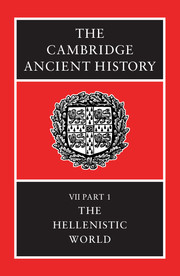Book contents
- Frontmatter
- 1 Sources for the period
- 2 The succession to Alexander
- 3 Monarchies and monarchic Ideas
- 4 The formation of the Hellenistic kingdoms
- 5 Ptolemaic Egypt
- 6 Syria and the East
- 7 Macedonia and Greece
- 8 Cultural, social and economic features of the Hellenistic world
- 9 Hellenistic science: its application in peace and war
- 10 Agathocles
- 11 The Syrian-Egyptian Wars and the new lingdoms of Asia Minor
- 12 Macedonia and the Greek leagues
- BIBLIOGRAPHY
- Index
- Map 3. Egypt.
- Map 4. Hellenistic Asia.
- Map 5. The Greek mainland and the Aegean.
- References
12 - Macedonia and the Greek leagues
Published online by Cambridge University Press: 28 March 2008
- Frontmatter
- 1 Sources for the period
- 2 The succession to Alexander
- 3 Monarchies and monarchic Ideas
- 4 The formation of the Hellenistic kingdoms
- 5 Ptolemaic Egypt
- 6 Syria and the East
- 7 Macedonia and Greece
- 8 Cultural, social and economic features of the Hellenistic world
- 9 Hellenistic science: its application in peace and war
- 10 Agathocles
- 11 The Syrian-Egyptian Wars and the new lingdoms of Asia Minor
- 12 Macedonia and the Greek leagues
- BIBLIOGRAPHY
- Index
- Map 3. Egypt.
- Map 4. Hellenistic Asia.
- Map 5. The Greek mainland and the Aegean.
- References
Summary
THE REIGN OF DEMETRIUS II
On his death in 239 Antigonus II was succeeded without challenge by his son Demetrius II, who had shouldered much of the administration during his last years, perhaps with a special responsibility for the northern frontiers, and had indeed been co-regent at least since 257/6. His accession was followed almost at once by several major changes in areas affecting Macedonia. About the time of Antigonus' death Alexander of Epirus had also died, leaving his widow Olympias as guardian to their two sons, Pyrrhus and Ptolemy. This moment of weakness for the Epirote kingdom offered an opportunity for aggrandizement which the Aetolians could not resist and in 239 they invaded western Acarnania, which Epirus had received as its share in the agreed dismemberment of that state. In reply Olympias asked for help from the new king of Macedonia, offering him her daughter Phthia (also called Chryseis) in marriage to seal an alliance, and Demetrius accepted, thereby effecting an open breach with the Aetolians. His motives can only be surmised. It has been suggested that a strong Epirus bound closely to Macedonia would be a bulwark against the Illyrians; but it was the Dardanians rather than the Illyrians of the Adriatic region who had posed the greatest threat to Macedonia and Demetrius may have had his eyes on the Aetolians themselves. Realizing that they were already edging towards an agreement with Achaea, he may well have decided to jettison any hope of retaining their goodwill as the price of establishing a friendly and, with luck, subservient Epirus on his western frontier.
Keywords
- Type
- Chapter
- Information
- The Cambridge Ancient History , pp. 446 - 481Publisher: Cambridge University PressPrint publication year: 1984
References
- 13
- Cited by

